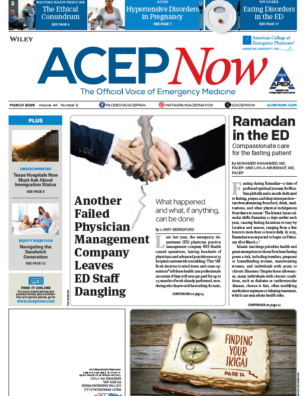
New Data Haven’t Changed Ophthalmology’s Myopic View of Topical Anesthetics for Corneal Abrasions
For decades, emergency physicians have challenged the premise that topical anesthetics used for a short duration of time (eg, hours to days) couldn’t possibly harm patients. This seems like a reasonable, common-sense argument, which should prompt widespread adoption. However, emergency physicians who were bold enough to go rogue on this topic were met with great resistance. Apparently, commonsense is no match for the myopic dogma about this topic in the ophthalmological community.
Explore This Issue
ACEP Now: Vol 37 – No 09 – September 2018Perhaps, randomized controlled trials would be necessary to unequivocally demonstrate that the safety of the short-term use of topical anesthetics (eg, tetracaine) for corneal abrasions.
The Data
The roots of dogmatism and myth propagation run deep—in this case, very deep. Three credible studies, which were published in 2014, more than adequately reflect the safety of the short-term use of tetracaine for corneal abrasions. The first, was published by Waldman et al in 2014.1 This prospective, randomized, double-blind study of 116 patients compared undiluted tetracaine (1%) to saline in patients presenting with uncomplicated corneal abrasions during a 12-month period. The drops could be applied every 30 minutes while the patient was awake for a maximum of 24 hours. No tetracaine-attributable complications were noted in the treatment group, and there was no statistically significant difference in delayed corneal healing (defined as fluorescein update at 48 hours) between the two groups (23.9 percent for tetracaine versus 21.3 percent for saline).
In 2015, Puls et al performed a systemic review and meta-analysis that included two randomized trials.2 They reported no significant differences in pain, persistent symptoms, or corneal healing. Although their data reflected an odds ratio for delayed healing of 1.31 for those receiving topical anesthetics for 72 hours or less, suggesting 31 percent greater odds for delayed healing with topical anesthetics, the bottom line is that no complications from treatment were noted. Also published in 2015 was a systematic review that included the two randomized trials Puls identified, as well as four additional studies evaluating topical anesthetic use in patients following photorefractive keratectomy.3 They reached similar conclusions: “Our literature search produced two emergency department-based, randomized, double-blind, placebo-controlled studies on human patients with corneal abrasions. Additionally, we found four studies that investigated the application of topical anesthetics in patients who underwent photorefractive keratectomy. All six studies demonstrated that a short course of dilute topical anesthetic provided efficacious analgesia without adverse effects or delayed epithelial healing.”
Pages: 1 2 3 4 | Single Page




No Responses to “Science Has Repeatedly Debunked this Stubborn Ophthalmology Myth”